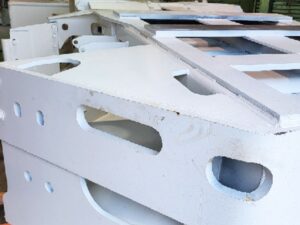7/09/23

Summary
This case study describes how a coal producer used portable 3D laser scanner to capture the geometry of a coal shuttle car for reverse engineering as there is no design drawing available. The company aimed to replace worn-out vehicles and manufacturing new machines for more mining operations. The engineer scanned the top and bottom of the chassis using a handheld scanner KSCAN-Magic and ensured the high-precision results with its built-in photogrammetry. The scanning process resulted in a high-quality 3D model of the coal shuttle car.
A coal shuttle car is a vehicle that carries coal from the mining to the conveyor system in underground mines. Coal shuttle cars are subject to wear and tear because of the rough conditions and heavy loads. Therefore, they require frequent maintenance or replacement.
One of the difficulties of maintaining or replacing these vehicles is that they have complicated shapes and large sizes that are hard to measure with traditional methods. Moreover, the original design drawings may be missing. Therefore, there is a demand for a quick and precise method to capture the shape of the existing coal shuttle cars.
The customer in this case is a leading coal producer that produces tens of millions tons of coal each year, with the help of several thousands of employees.

The company decided to use 3D scanning technology to capture the geometry of the coal shuttle car. By projecting laser beams onto the surfaces of the shuttle car, they can capture huge amount of data points per second and create a digital representation of the part.
The engineer used a handheld 3D laser scanner KSCAN-Magic that can scan objects of various sizes and shapes. The scanner has a built-in photogrammetry that can help ensure the high-precision of measuring large-scale parts.
The KSCAN-Magic series of 3D laser scanners is the first to combine two types of lasers in one device: infrared and blue.
It has five standard working modes for different scanning needs:
It also has two sets of high-resolution industrial cameras for detailed 3D scanning.
Take portable 3D scanner to the site: Thanks to the compact size of the industrial 3D scanner KSCAN-Magic, the engineer carried this equipment easily to the site where the coal shuttle car was located.
Apply coded and non-coded markers: The engineer applied small coded and non-coded markers on the surface of the coal shuttle car. These markers help the scanner position the part and align multiple scans together.
Take photos for photogrammetry: The engineer took several photos of the coal shuttle car from different angles using KSCAN-Magic’s built-in photogrammetry. These photos were used to create a general geometry of the coal shuttle car.
Create marker file for entire chassis: The engineer collected and exported the coordinates of all the markers on the coal shuttle car. This file was used as a reference for aligning the scans later.
Scanning the bottom of the chassis: The engineer scanned the bottom of the chassis by moving the high-precision 3D scanner around the object. The scanner captured data points in real time and displayed them on the laptop screen. The engineer scanned different sections of the chassis until all areas were covered.
Flip chassis and scan the top: The engineer flipped the chassis over and scanned the top using the same method.
Re-align top scan to bottom scan: The engineer used the scanning software to align the top scan to the bottom scan using the marker point file as a reference. The software merged the two laser scans into one 3D model.
The 3D model accurately represented the complex geometry and fine details of the coal shuttle car, meeting the requirements for accuracy. The engineer exported the high-resolution mesh, which is compatible with most CAD software. In this way, the customer can manufacture new coal shuttle cars to fulfill the needs of new operations. Besides, 3D scanning also offers them opportunities to modify, analyze, or redesign the coal shuttle car when necessary.
This case study demonstrated how a company used 3D scanning to capture the geometry of a coal shuttle car without original design drawing to manufacture new vehicles for mining.
The 3D scanning technology offers several benefits, such as:
The 3D scanning technology is a powerful tool for capturing the geometry of various objects for different applications. It can help engineers, designers, and researchers solve problems and create solutions more efficiently.